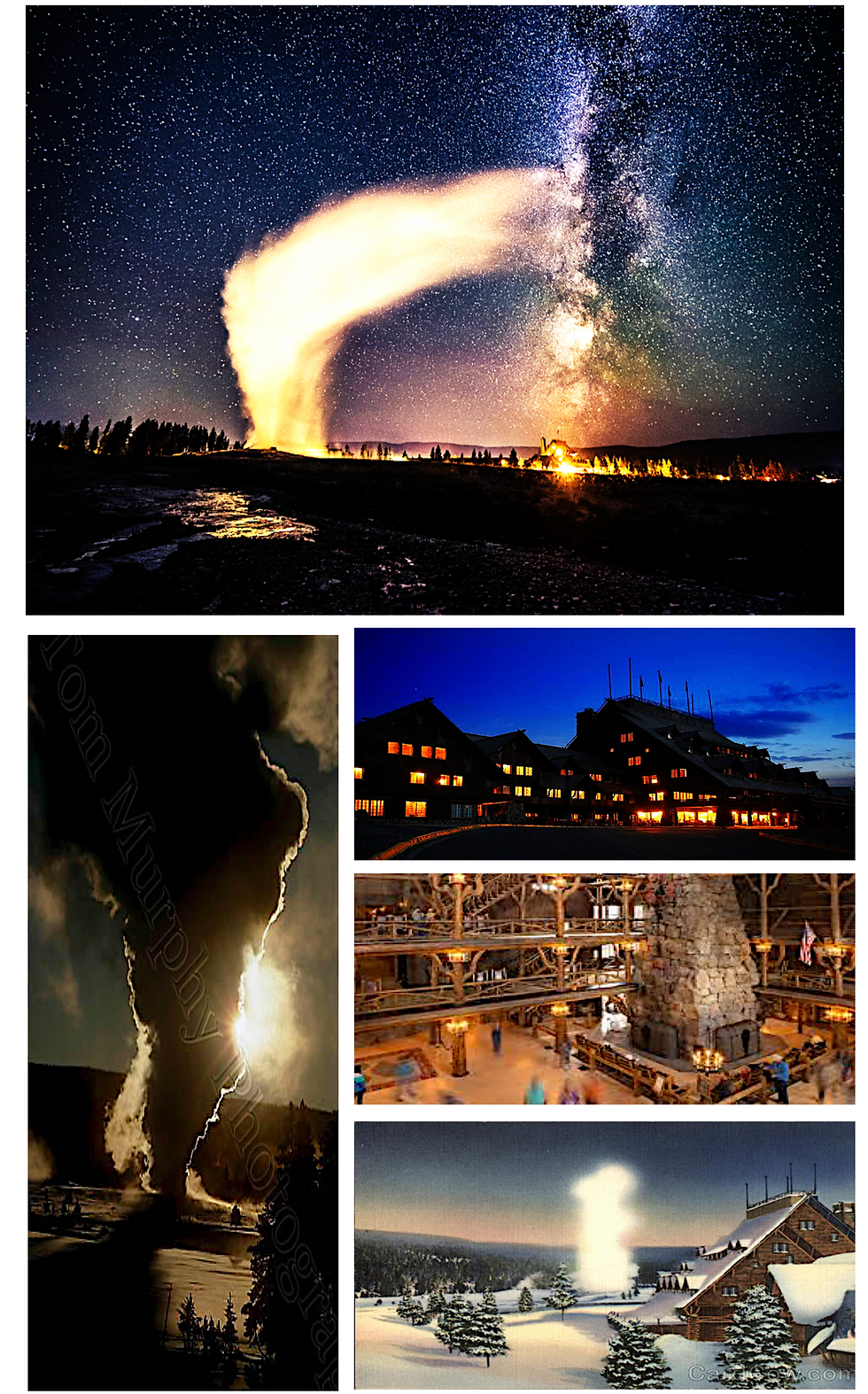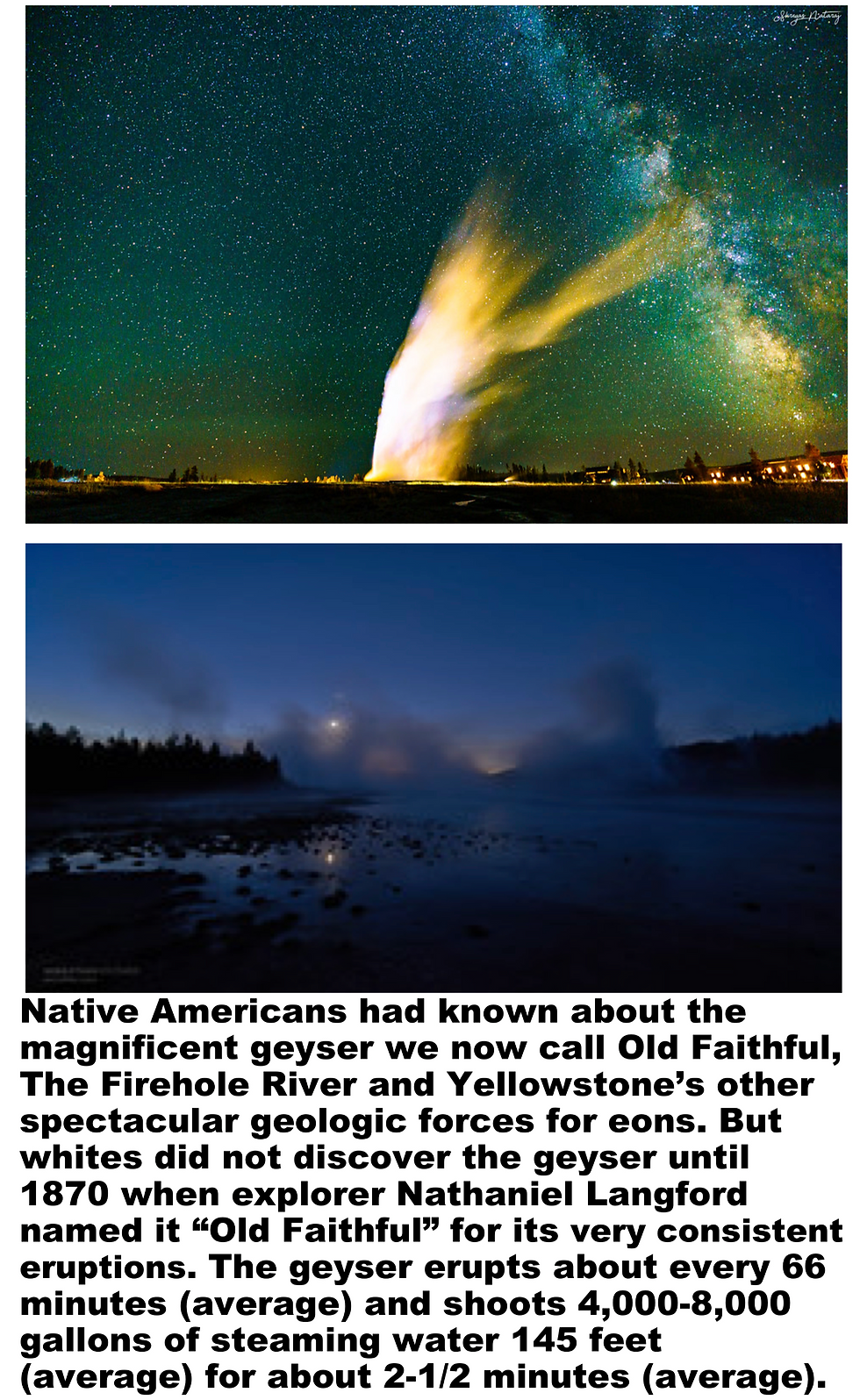Welcoming the New Year with Old Faithful
- Notes From The Frontier

- Dec 31, 2019
- 6 min read
Updated: Jan 1, 2022
It's one of the most spectacular natural wonders of the West. For hundreds of years, some have been lucky enough to see Nature's own fireworks welcome in the new year!

Americans have long welcomed the New Year with fireworks, watching the Times Square giant ball spectacle and, sometimes, drinking to access. But here’s an idea on how to celebrate the New Year frontier-style, under the stars, and with the natural world. Oh, you’ll become intoxicated alright---but on Nature’s spectacular pageantry and you’ll see fireworks and exploding light, as the world’s most famous geyser as it shoots to the stars to meld with the Milky Way in a fantastic marriage of earth and sky.

The First Americans have been marveling at Old Faithful for thousands of years. They regard it—and the geologic wonders of Yellowstone’s surrounding it—as sacred. And sacred it is, one of the most magnificent natural wonders of our continent and an icon of the West. Today, near the geyser is the Old Faithful Inn, the largest and oldest lodge in the national park system and spectacular in its own humanmade rite; it is the largest log structure in the world and built in 1904 when all Americans were clamoring to see our continent’s first national park and its most famous geyser.
The log inn has a massive cathedral ceiling 76-feet high and an equally massive stone fireplace that weighs 500 tons and towers 84-feet—more than six stories—into the sky. But, still the humanmade wonder is dwarfed by Old Faithful when it erupts. The geyser can shoot nearly 200 feet into the sky and showers the entire area with a volcano of steam and streams of water like shooting stars.

Old Faithful and the many other natural wonders of Yellowstone were among the last areas in the frontier West to be “discovered” by whites because the land was so rugged and inaccessible. But Native Americans had lived in and loved the land for thousands of years. About 26 Native tribes had ancestral connections to the land that is today Yellowstone National Park, among them the Sheepeaters of the Mountain Shoshones, Crows, Bannocks, Blackfeet, Flatheads, Kiowas, Arapahoes, Nez Perce, Assinboines, Northern Cheyennes, Gros Ventres, Sioux, and other tribes who inhabited the upper Yellowstone country and its edges at various times prior to white exploration.
Tribes had different names for Yellowstone. The Crow called it “land of the burning ground” or “land of vapors.” The geysers were called bide-mahpe, which means “sacred or powerful water.” The Blackfeet named the land “many smoke,” the Flatheads, “smoke from the ground” and the Kiowa called it “the place of hot water.” The Nez Perce called it “the creator’s unfinished land” because the terrain was so rugged and seemingly opened in places to the depths of the earth.

In fact, some Native scholars today say that about 1,600 cultural tribal sites exist within the area of Yellowstone National Park, including the geyser named Old Faithful by whites. There are also efforts by tribal groups today to change some of the names
of Yellowstone landmarks such as Mount Doane and Hayden Valley, because they were named after white leaders who led extermination efforts of resident Native American people in the 1800s.
The Park area was a long-time permanent home of the Mountain Shoshone called “Sheepeaters” because they ate a regular diet of mountain sheep and lived at an altitude of about 7,500 above sea level. Many more tribes visited the land as a sacred place. The Nez Perce would make annual pilgrimages to the area and relax in the steaming waters of Yellowstone on their way to hunt buffalo on the Plains with the Crow.
The Park straddles three corners of Wyoming, Idaho and Montana and the northern end of the Grand Canyon. The entrance to Yellowstone is from the north, and the route was remote and very difficult. Native Americans had long told extraordinary stories about violent and phantasmagoric geothermal features and geologic formations, about steaming vapors, wildly colored waters and stone, bubbling ground, and incredible cliffs and canyons. Such stories were so fantastic, whites often thought they were simply legend and not to be believed. But, then mountain men and early explorers reported what Native Americans had been telling all along.

It was not until September 1870 that the members of the Washburn-Langford-Doane Expedition traveled down the Firehole River from the Kepler Cascades down and entered the Upper Geyser Basin. The first geyser that they saw was Old Faithful. Nathaniel Langford wrote in his 1871 Scribner's account of the expedition:
“It spouted at regular intervals nine times during our stay, the columns of boiling water being thrown from ninety to one hundred and twenty-five feet at each discharge, which lasted from fifteen to twenty minutes. We gave it the name of ‘Old Faithful.’ ”
That expedition opened Yellowstone to the American public’s deep fascination with the area and on March 1, 1872, President Ulysses S. Grant signed a bill to create Yellowstone National Park, the country’s first national park. The bill recognized the “natural curiosities and wonders within” the world’s first federally protected national park and set apart 2.2 million acres as a “public park or pleasuring-ground for the benefit and enjoyment of the people.” Congress quickly passed the bill. The land was still unexplored and unclaimed by pioneers. Yellowstone National Park remains the only national park that that was established before settlers made bids for the land.

Early in the Park’s history, when white Victorians began visiting the land in hoards, park officials tried to make the area “safe” for tourists by removing Native Americans from their sacred spots and began spreading rumors that the “primitives” did not live in the area because they feared the geysers and strange thermal activity as being possessed by spirits. But, in fact, Native Americans revered and respected the land and regarded it as sacred.
White promoters poured into the area with grandiose plans for development, but the federal government, thankfully, limited access and made preserving the natural beauty of the land a priority. The Yellowstone Act of 1872 cut short development, acts of vandalism, and treasure hunters who came to deface the land rather than honor it.

Some early structures were constructed, but around 1900 plans for a spectacular giant log lodge were began for the Old Faithful Inn, constructed out of the areas native forests and stone. The architecture was to be rugged and log-cabin like, a style that would become known as “Parkitecture” and would be repeated in other national and state parks across the nation.
Old Faithful Inn would be completed in 1904 with a souring, six-story high, raw timber ceiling and a massive, 500-ton stone chimney with four fireplaces were the centerpiece of the lodge. Today, it is the largest and oldest national park structure. The Inn was built only minutes from Old Faithful itself. The area has been designated as the Old Faithful Historic District. The lodge hosts tours to Old Faithful. And there are other tours for the area’s natural wonders and wildlife, including horse-and-sleigh excursions in winter!
Tour guides will tell you about Old Faithful and Yellowstone’s many other geothermal wonders. And they’ll tell you why Yellowstone is so blessed with these strange phenomena: Old Faithful and Yellowstone sit atop North America’s largest volcano. It’s not just any volcano---it’s a supervulcano that, if it erupted, would be thousands of times more powerful than regular volcanos. It could wipe out two-thirds of the United States and bury states as far away as Texas in five feet of ash.

(But, don’t worry. Its eruptions happened millions of years ago, the most recent about 664,000 years ago. And scientists believe any possible eruptions would not happen for hundreds or thousands of years. In fact, there is a high chance Yellowstone’s supervolcano may never erupt again.)
But, even though the spirits that lurk far beneath the earth may be sleeping, they are not to be forgotten. Pressure build-ups under the earth’s surface cause Old Faithful to erupt on regular intervals. More than 1,000,000 eruptions have been recorded since 1938. In 1939, the geyser erupted on the average about every 66.5 minutes. Since then,
the intervals have slowly increased. After the Borah Peak earthquake in central Idaho in October 1983, intervals have lengthened noticeably longer to about 90 minutes. Today the timing of eruptions varies from 60 to 110 minutes. Depending on the pressure-buildup, the boiling water shoots 106 to 185 feet high and lasts from 1-1/2 to 5 minutes.

To witness Yellowstone’s most famous geyser and the park’s other fantastical wonders is the opportunity of a lifetime. We can experience the natural world at its most magnificent just as Native Americans did for thousands of years.
At the end of each year and the beginning of a new one, several hundred guests from all over the world are lucky enough to stay at Old Faithful Inn and commune with Nature and Old Faithful to welcome the New Year. What better way to celebrate a new calendar year and the passing of our time on earth, but with Nature’s timeless rhythms and one of her most spectacular gifts to humankind?
"Welcoming the New Year with Old Faithful" was first posted on Facebook and NotesfromtheFrontier.com on December 31, 2019.
184,724 views / 1,843 likes / 827 shares
© 2021 NOTES FROM THE FRONTIER



